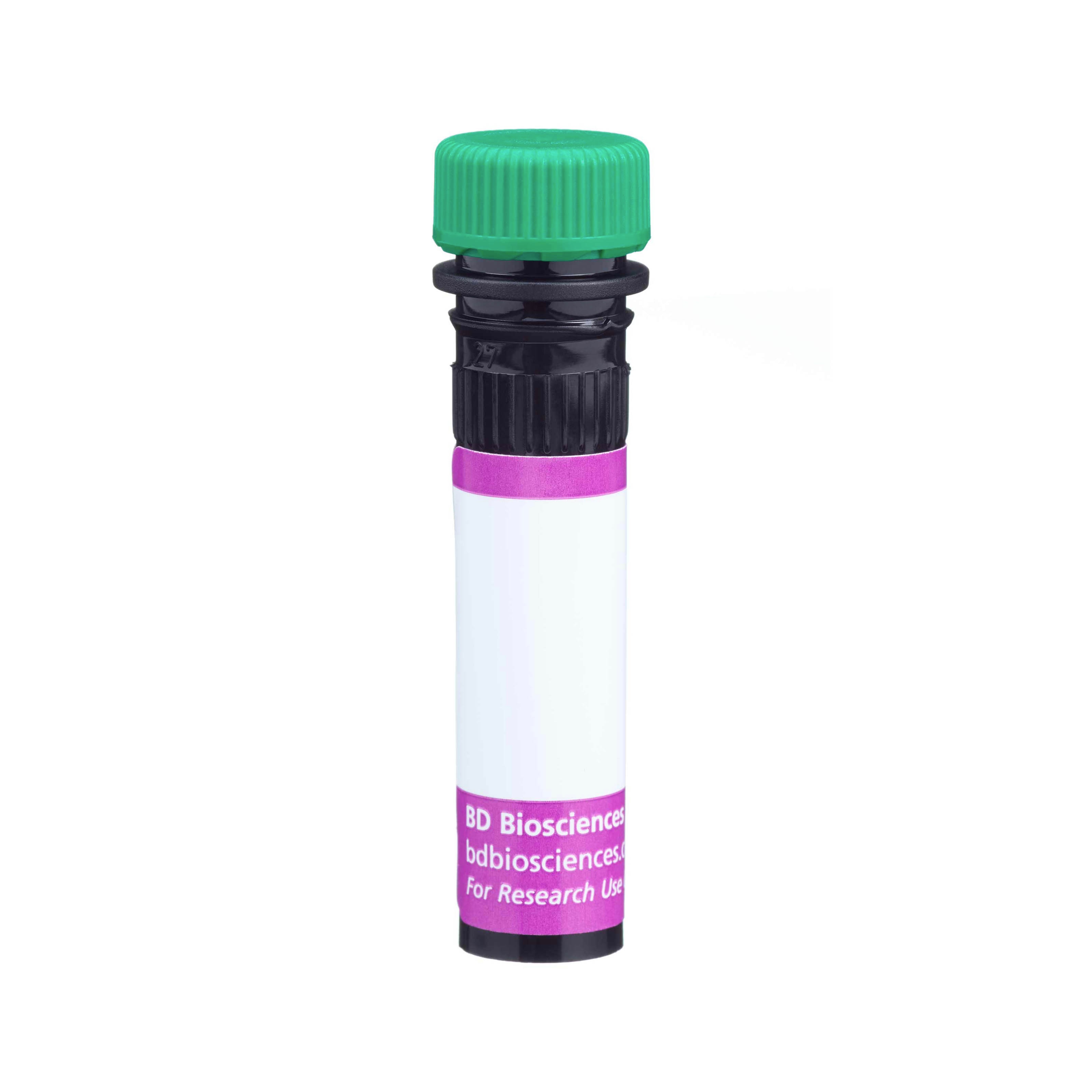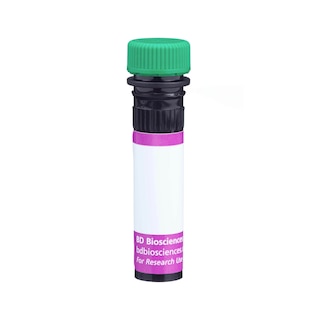-
Training
- Flow Cytometry Basic Training
-
Product-Based Training
- BD Accuri™ C6 Plus Cell Analyzer
- BD FACSAria™ Cell Sorter Cell Sorter
- BD FACSCanto™ Cell Analyzer
- BD FACSDiscover™ A8 Cell Analyzer
- BD FACSDiscover™ S8 Cell Sorter
- BD FACSDuet™ Sample Preparation System
- BD FACSLyric™ Cell Analyzer
- BD FACSMelody™ Cell Sorter
- BD FACSymphony™ Cell Analyzer
- BD LSRFortessa™ Cell Analyzer
- Advanced Training
Old Browser
This page has been recently translated and is available in French now.
Looks like you're visiting us from {countryName}.
Would you like to stay on the current location site or be switched to your location?
BD Horizon™ BV510 Mouse Anti-Human CD206 (Mannose Receptor)
Clone 19.2 (RUO)

Flow cytometric analysis of CD206 (Mannose Receptor) expression on viable GM-CSF-stimulated monocytes. Human peripheral blood mononuclear cells (PBMC) were cultured for 3 days with Recombinant Human GM-CSF protein (Cat. No. 550068). The cells were harvested and stained with either BD Horizon™ BV510 Mouse IgG1, κ Isotype Control (Cat. No. 562946; dashed line histogram) or BD Horizon™ BV510 Mouse Anti-Human CD206 (Mannose Receptor) antibody (Cat. No. 569618; solid line histogram) at 1.0 μg/test. BD Via-Probe™ Cell Viability 7-AAD Solution (Cat. No. 555815/555816) was added to cells right before analysis. The fluorescence histogram showing CD206 (Mannose Receptor) expression (or Ig Isotype control staining) was derived from gated events with the forward and side light-scatter characteristics of viable (7-AAD-negative) GM-CSF activated monocytes. Flow cytometry and data analysis were performed using a BD FACSCelesta™ Cell Analyzer System and FlowJo™ software. Data shown on this Technical Data Sheet are not lot specific.


Flow cytometric analysis of CD206 (Mannose Receptor) expression on viable GM-CSF-stimulated monocytes. Human peripheral blood mononuclear cells (PBMC) were cultured for 3 days with Recombinant Human GM-CSF protein (Cat. No. 550068). The cells were harvested and stained with either BD Horizon™ BV510 Mouse IgG1, κ Isotype Control (Cat. No. 562946; dashed line histogram) or BD Horizon™ BV510 Mouse Anti-Human CD206 (Mannose Receptor) antibody (Cat. No. 569618; solid line histogram) at 1.0 μg/test. BD Via-Probe™ Cell Viability 7-AAD Solution (Cat. No. 555815/555816) was added to cells right before analysis. The fluorescence histogram showing CD206 (Mannose Receptor) expression (or Ig Isotype control staining) was derived from gated events with the forward and side light-scatter characteristics of viable (7-AAD-negative) GM-CSF activated monocytes. Flow cytometry and data analysis were performed using a BD FACSCelesta™ Cell Analyzer System and FlowJo™ software. Data shown on this Technical Data Sheet are not lot specific.

Flow cytometric analysis of CD206 (Mannose Receptor) expression on viable GM-CSF-stimulated monocytes. Human peripheral blood mononuclear cells (PBMC) were cultured for 3 days with Recombinant Human GM-CSF protein (Cat. No. 550068). The cells were harvested and stained with either BD Horizon™ BV510 Mouse IgG1, κ Isotype Control (Cat. No. 562946; dashed line histogram) or BD Horizon™ BV510 Mouse Anti-Human CD206 (Mannose Receptor) antibody (Cat. No. 569618; solid line histogram) at 1.0 μg/test. BD Via-Probe™ Cell Viability 7-AAD Solution (Cat. No. 555815/555816) was added to cells right before analysis. The fluorescence histogram showing CD206 (Mannose Receptor) expression (or Ig Isotype control staining) was derived from gated events with the forward and side light-scatter characteristics of viable (7-AAD-negative) GM-CSF activated monocytes. Flow cytometry and data analysis were performed using a BD FACSCelesta™ Cell Analyzer System and FlowJo™ software. Data shown on this Technical Data Sheet are not lot specific.



Regulatory Status Legend
Any use of products other than the permitted use without the express written authorization of Becton, Dickinson and Company is strictly prohibited.
Preparation And Storage
Recommended Assay Procedures
BD® CompBeads can be used as surrogates to assess fluorescence spillover (Compensation). When fluorochrome conjugated antibodies are bound to CompBeads, they have spectral properties very similar to cells. However, for some fluorochromes there can be small differences in spectral emissions compared to cells, resulting in spillover values that differ when compared to biological controls. It is strongly recommended that when using a reagent for the first time, users compare the spillover on cells and CompBead to ensure that BD® CompBeads are appropriate for your specific cellular application.
For optimal and reproducible results, BD Horizon Brilliant™ Stain Buffer should be used anytime BD Horizon Brilliant dyes are used in a multicolor flow cytometry panel. Fluorescent dye interactions may cause staining artifacts which may affect data interpretation. The BD Horizon Brilliant Stain Buffer was designed to minimize these interactions. When BD Horizon Brilliant Stain Buffer is used in in the multicolor panel, it should also be used in the corresponding compensation controls for all dyes to achieve the most accurate compensation. For the most accurate compensation, compensation controls created with either cells or beads should be exposed to BD Horizon Brilliant Stain Buffer for the same length of time as the corresponding multicolor panel. More information can be found in the Technical Data Sheet of the BD Horizon Brilliant Stain Buffer (Cat. No. 563794/566349) or the BD Horizon Brilliant Stain Buffer Plus (Cat. No. 566385).
Product Notices
- Please refer to www.bdbiosciences.com/us/s/resources for technical protocols.
- Caution: Sodium azide yields highly toxic hydrazoic acid under acidic conditions. Dilute azide compounds in running water before discarding to avoid accumulation of potentially explosive deposits in plumbing.
- Since applications vary, each investigator should titrate the reagent to obtain optimal results.
- For fluorochrome spectra and suitable instrument settings, please refer to our Multicolor Flow Cytometry web page at www.bdbiosciences.com/colors.
- An isotype control should be used at the same concentration as the antibody of interest.
- BD Horizon Brilliant Violet 510 is covered by one or more of the following US patents: 8,575,303; 8,354,239.
- BD Horizon Brilliant Stain Buffer is covered by one or more of the following US patents: 8,110,673; 8,158,444; 8,575,303; 8,354,239.
- Human donor specific background has been observed in relation to the presence of anti-polyethylene glycol (PEG) antibodies, developed as a result of certain vaccines containing PEG, including some COVID-19 vaccines. We recommend use of BD Horizon Brilliant™ Stain Buffer in your experiments to help mitigate potential background. For more information visit https://www.bdbiosciences.com/en-us/support/product-notices.
- Please refer to http://regdocs.bd.com to access safety data sheets (SDS).
- For U.S. patents that may apply, see bd.com/patents.
Companion Products






The 19.2 monoclonal antibody specifically binds to CD206 which is also known as the macrophage mannose receptor (MMR) or C-type lectin domain family 13 member D (CLEC13D). CD206 is a type I transmembrane glycoprotein of approximately 162 kDa which binds to glycoconjugates containing mannose, fucose, or N-acetylglucosamine. These carbohydrates are present on the surface of many microorganisms and enable the macrophage to bind to microorganisms through the MMR and internalize them during the process of phagocytosis. CD206 is expressed on human macrophages, endothelial cells, and cultured dendritic cells. It is not detected on resting monocytes. Mannose receptor expression is upregulated on peripheral blood mononuclear cells following 3 day incubation with GM-CSF.

Development References (5)
-
Condaminet B, Peguet-Navarro J, Stahl PD, Dalbiez-Gauthier C, Schmitt D, Berthier-Vergnes O. Human epidermal Langerhans cells express the mannose-fucose binding receptor. Eur J Immunol. 1998; 28(11):3541-3551. (Immunogen: Flow cytometry). View Reference
-
Hart DNJ, Clark GJ, MacDonald K, et al. Dendritic Cells Section Summary. In: Mason D. David Mason .. et al., ed. Leucocyte typing VII : white cell differentiation antigens : proceedings of the Seventh International Workshop and Conference held in Harrogate, United Kingdom. Oxford: Oxford University Press; 2002:283-294.
-
Mason D. David Mason .. et al., ed. Leucocyte typing VII : white cell differentiation antigens : proceedings of the Seventh International Workshop and Conference held in Harrogate, United Kingdom. Oxford: Oxford University Press; 2002.
-
Pontow SE, Kery V, Stahl PD. Mannose receptor. Int Rev Cytol. 1992; 137(B):221-244. (Biology). View Reference
-
Zola H, Swart B, Boumsell L, Mason DY. Human Leucocyte Differentiation Antigen nomenclature: update on CD nomenclature. Report of IUIS/WHO Subcommittee.. J Immunol Methods. 2003; 275(1-2):1-8. (Clone-specific: Flow cytometry). View Reference
Please refer to Support Documents for Quality Certificates
Global - Refer to manufacturer's instructions for use and related User Manuals and Technical data sheets before using this products as described
Comparisons, where applicable, are made against older BD Technology, manual methods or are general performance claims. Comparisons are not made against non-BD technologies, unless otherwise noted.
For Research Use Only. Not for use in diagnostic or therapeutic procedures.